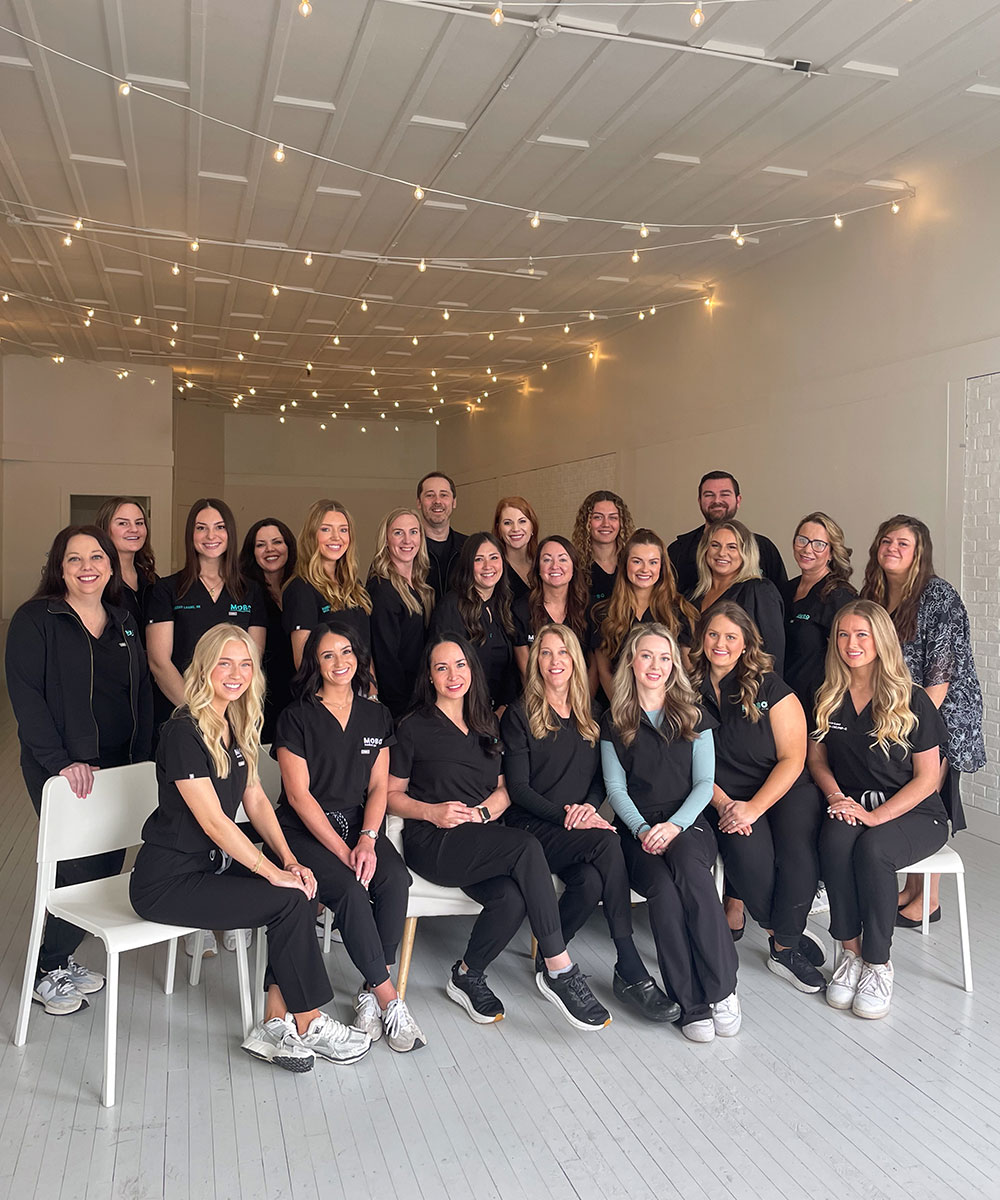Written by Lauren Lund, APRN-CNP
Reviewed by Laurianne Scott, DO, OBGYN
Last Updated on 09/30/2025
*DRAFT AS OF 9/28/2025
What Is Low Testosterone?
Testosterone is the primary male sex hormone that plays an important role in energy, muscle mass, bone density, mood, and sexual health. Levels tend to naturally decline with age, but some men experience low testosterone (also called hypogonadism) that leads to bothersome symptoms and impacts overall health.
What is a low testosterone level?
Blood testing is recommended prior to the diagnosis and treatment of low testosterone.
- Total Testosterone (TT): Total testosterone includes all testosterone in the bloodstream (bound + free). The American Urology Association (AUA) considers low blood testosterone to be less than 300 nanograms per deciliter (ng/dL) for male adults.
- Free Testosterone (T): Free testosterone includes only the small portion that's not bound, and directly usable by the body.
MOBO Medical Spa providers may order adjustive testing.
- Luteinizing hormone (LH): LH (luteinizing hormone) is tested in men to determine whether low testosterone is due to a problem in the testes (primary hypogonadism) or in the brain’s signaling from the pituitary/hypothalamus (secondary hypogonadism). This is explained in more detail in the following section.
- Serum prolactin: Patients with persistently high prolactin levels of unknown cause may be referred to an endrocrinologist.
- Prostate Stimulating Antigen (PSA): PSA can be measured in men over 40 years of age prior to start of testosterone therapy to exclude a prostate cancer diagnosis.
- Serum estradiol (E2): Men have estrogens too. Serum E2 levels may be measured in a patient with baseline gynecomastia or breast symptoms
- Hemoglobin A1C: used to assess the risk of pre-diabetes and diabetes. Patients with diabetes are at risk for low testosterone.
- Lipid Panel:
- Complete Metabolic Panel (CMP):
- Complete Blood Count (CBC): Prior to the start of testosterone therapy, a CBC with hemoglobin and hematocrit may be assessed due to the potential risk of polycythemia with testosterone thrapy.
At MOBO Medical Spa, both symptoms and lab results are considered before making a diagnosis.
What are the causes of low testosterone in men?
The are 2 main different types of low testosterone in men: (1) Primary hypogonadism and (2) Secondary hypogonadism.
Primary Hypogonadism:
- What's Happening Physically: The testes are not producing enough testosterone, even though the brain (pituitary gland) is signaling the testes to do so.
- Labs: Lab may reveal low testosterone with high luteinizing hormone (LH) and high follicle-stimulating hormone (FSH)
- Common Causes: Genetic conditions (e.g., Klinefelter syndrome), Testicular injury, surgery, or radiation, Infections (such as mumps orchitis), or Aging-related testicular function decline
Secondary Hypogonadism:
- What's Happening Physically: The pituitary gland is not producing enough signals (LH and FSH) to stimulate the testes; however the testes are capable of producing testosterone but the testes aren’t being told to.
- Labs: Labs may reveal low testosterone with low or inappropriately normal LH and FSH.
- Common Causes: Pituitary tumors or hypothalamic disease, Head trauma, surgery, or radiation affecting the pituitary, Chronic illness, obesity, or certain medications (e.g., opioids, glucocorticoids), Functional causes such as stress or significant weight loss
Who is most affected by low testosterone?
Male low testosterone (hypogonadism) can affect men at any age; however it is more common in older age. According to The American Urological Association (2025), a meta-analysis of the literature suggests that men who have the following listed conditions are at risk for low testosterone:
- a history of unexplained anemia
- bone density loss
- diabetes
- exposure to chemotherapy
- direct or scatter radiation therapy to the testes
- HIV
- history of chronic narcotic use
- infertility
- pituitary disorders
- chronic corticosteroid use
Symptoms of Low Testosterone
Men with low testosterone may experience a wide range of symptoms. Symptoms may include, but are not limited to, the following:
- fatigue and reduced energy
- reduced endurance
- diminished work performance
- diminished physical performance
- loss of muscle mass and strength
- increased body fat
- gynecomastia (enlarged breasts in men)
- decreased bone density (seen on DEXA scan) or increased risk of fractures
- visual field changes (bitemporal hemianopsia)
- anosmia (loss of the sense of smell)
- thinning body or facial hair
- depression
- anxiety
- irritability
- reduced motivation
- poor concentration or "brain fog"
- impaired memory
- infertility
- reduced sex drive
- changes in erectile function
Because these symptoms can overlap with other medical conditions, a thorough medical evaluation and lab work is necessary before diagnosis and starting treatment.
Prescription Treatment of Low Testosterone
There are many different types of medication treatments for low testosterone. The goal of treatment is largely aimed on the treatment of symptoms, not the specific testosterone level.
According to The American Urological Association (2025), men with testosterone deficiency who are interested in fertility / having biological children should have a reproductive health evaluation performed prior to treatment. Exogenous testosterone therapy should not be prescribed to men who are currently trying to conceive.
Prescription Options:
MOBO Medical Spa providers may offer the following testosterone prescriptions:
- Testosterone skin gels:
- Use: Follow directions on your prescription. Typically it is applied every day to clean, dry skin in the morning after showering. Allow the application site to dry before dressing. Wash hands thoroughly after application.
- It’s important that you don’t transfer the gel to another person or pet through skin-to-skin contact.
- Learn more: HERE
- Intramuscular testosterone injections:
- Use: Follow directions on your prescription. Typically, the testosterone injections are injected into a muscle every 1 to 2 weeks. Learn more about HOW TO INJECT TESTOSTERONE.
- Testosterone pellets:
- Testosterone pellets are tiny, rice-sized implants placed just under the skin by your provider that slowly release a steady dose of testosterone over several months. They provide men with a convenient, long-acting option for hormone replacement therapy without the need for daily or weekly treatments.
Potential Side Effects:
Side effects of testosterone therapy are often dose dependent. Potential side effects of testosterone therapy may include but are not limited to:
- Acne or oily skin.
- Edema (Swelling in your ankles) caused by mild fluid retention
- Breast enlargement or tenderness.
- Worsening of sleep apnea
- Smaller testicles
- Skin irritation (if you are prescribed topical testosterone)
- Pellet excursion (if you are prescribed testosterone pellets)
Lifestyle Changes to Help Manage Low Testosterone
- Diet: At MOBO Medical Spa, we generally recommend an intermittent fasting schedule and a Mediterranean Anti-Inflammatory Diet. Eating a Mediterranean anti-inflammatory diet can help support healthy testosterone levels by reducing chronic inflammation, improving insulin sensitivity, and promoting cardiovascular health—all of which influence hormone balance. This way of eating, rich in omega-3 fats, fiber, antioxidants, and lean proteins, may also lower the risk of obesity and metabolic syndrome, two common contributors to low testosterone.
- Supplements: Addressing nutritional deficencies is key to healthy hormone balance.
- Vitamin D
- Vitamin B12
- DIM Evail
- Magnesium Glycinate
- Exercise: Some studies have shown that exercise can increase testosterone levels naturally. MOBO Medical Spa providers recommend a minimum of 30 minutes per day of activity. Exercises can include strength/resistance training, cardiovascular training (incline walking).
- Alcohol: Avoid or limit drinking alcohol. Alcohol can cause disruption in hormone regulation.
- Environmental Toxins: Studies have shown that chemicals can affect testosterone levels. For example, BPA has been shown to lower testosterone levels. It is recommended to check the Environmental Working Group's Consumer Guides to see how you limit toxin exposure.
- Treating obesity: According to The American Urology Association (AUA), high body mass index (obesity) with low testosterone could put a patient at risk for a cardiovascular event. It may be recommended to begin a weight loss program while on testosterone therapy.
- Managing Underlying Conditions: Treating underlying conditions, such as sleep apnea, cardiovascular disease or diabetes, can help restore testosterone levels and improve symptoms.
- Psychological Support: Since low testosterone can lead to mood changes, seeking counseling or psychological support can help manage anxiety, depression, or irritability that may accompany low testosterone.
Follow-up of Men on Testosterone Therapy
Labs:
Book A Consultation
Are you or a friend or family member experiencing low testosterone symptoms? Schedule a consultation at MOBO Medical Spa for Testosterone Therapy.
References
The information provided in this blog post is for informational purposes only and is not intended as medical advice. The content shared here is based on general wellness principles and is not a substitute for professional medical evaluation, diagnosis, or treatment. Always consult with your healthcare provider before starting any new supplement regimen or making changes to your current health plan. This blog does not establish a patient-provider relationship, and the opinions expressed are solely those of the author. Please seek the guidance of your physician or another qualified healthcare professional for any medical concerns you may have.







